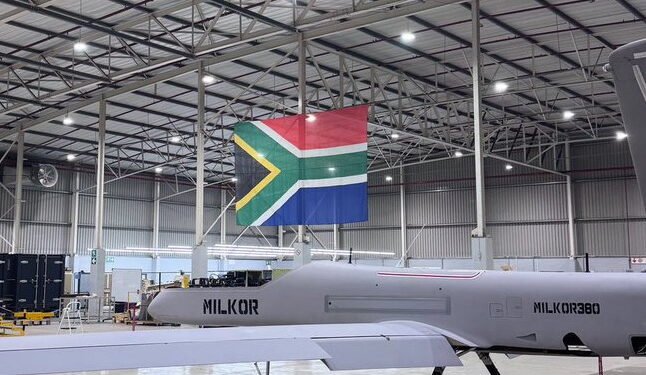
In an era of rapid technological advancements and evolving security threats, public-private partnerships (PPPs) have emerged as a powerful tool to strengthen South Africa’s defence and security capabilities, Milkor believes.
Speaking at the Public-Private Partnerships for Defence and Security (PPP) 2025 Conference in Pretoria on 7 March, Daniel du Plessis, Milkor’s Head of Business Development in Africa, highlighted the transformative potential of PPPs in modernising legacy systems, integrating cutting-edge technologies, and fostering innovation within the South African Defence Industry (SADI).
“By fostering collaborations between government entities and private industry we can revitalise existing capabilities, integrate cutting-edge technologies suited for purpose, and ensure that our defence forces and security cluster are well equipped to meet the contemporary challenges they face,” he said.
Du Plessis pointed to the challenges caused by the South African National Defence Force’s (SANDF’s) ageing fleet of military vehicles and weapon systems. He argued that PPPs offer a viable pathway to modernise these legacy systems in order to deal with current and future threats effectively while also allowing for the possible inclusion of new technologies into operations.
He noted the planned upgrade of the Rooivalk Mk 1 fleet to Mk 2 standard as exemplifying how collaboration between the public and private sectors can revitalise exiting weapon systems in order for them to meet contemporary challenges head on (private companies have offered to contribute systems like gimbals and guided rockets to a Rooivalk upgrade, for example).
Du Plessis pointed to the Milkor 380 unmanned aerial vehicle (UAV) as an example of the still present and innovative capabilities of the South African Defence Industry (SADI).
“There is a misconception, I think, among the general public in South Africa that a lot of skills have been and are being lost. Developing the Milkor 380 essentially forced us to use the best of the best skills available. This went all the way from aviation and aircraft engineers to system engineers and hardware and software specialists, and they are all residing in our company,” du Plessis told conference attendees.
“At the same time, we realised all the older people with a lot of experience can’t do all of the work and we therefore started scouting around the top four universities in South Africa for engineering and hardware and software development, essentially employing them from a graduate level.”
According to du Plessis, this scheme has been very successful and has allowed the company to develop and retain a new cohort of young, innovative, engineers who are set to lead the company’s development into the foreseeable future.
Additionally, du Plessis called on the wider SADI and the SANDF to adopt a similar approach moving forward as means to drive innovation in the South African defence and security environment.
“We cannot rely on old understandings and expertise solely. While they are important, to ensure an effective and sustainable defence industry and security cluster, it is vital that we transfer this knowledge to the next generation.”
Returning to the Milkor 380, du Plessis asserted that now that the technology is proven and moving to a production phase, the engineering team responsible for its development has the ability to move on to their new project, the Milkor 780. This high-altitude long endurance UAV project is well underway. The aircraft will weigh 5.5 tons and be capable of carrying over 2 700 kg of payload with a 30-40 hour flight endurance. “Should all go to plan, we will be launching this UAV at AAD 2026,” du Plessis said.
“There are only about eight countries that have officially developed a UAV the size of the Milkor 380, therefore it speaks volumes to the capabilities and innovation that still reside within the country. The question therefore is no longer, ‘is the SADI ready to revitalise the SANDF?’ but, ‘is government ready to fund this revitalisation project?’” du Plessis asked.
Localised support and local knowledge transfer
Du Plessis also spoke about the need to develop and maintain localised support infrastructure through PPPs, particularly in a time of significant geopolitical uncertainty. He also argued that such an approach would enhance operational successes as well ensure key skills are developed and maintained domestically, while also ensuring maintenance, repairs, and upgrades are done promptly and efficiently.
“This autonomy enhances our operational readiness and reduces the dependence on foreign entities. The establishment of a strong local support capability for all systems in use by the SANDF, the SAPS, and the BMA will ensure a high level of operational readiness and operational use.”
Moreover, du Plessis pointed to the importance of knowledge transfers within PPPs through a collaborative model with reliable partners. He argued that one of the primary benefits of PPPs is the exchange of knowledge which enables the development of innovative ideas and the transfer and retention of vital skills.
In concluding his address to the PPP 2025 conference, du Plessis emphasised Milkor’s commitment to South Africa and its view that “PPPs represent a strategic avenue for South Africa to enhance its defence and security capabilities. By reviving and modernising exiting systems, integrating cutting edge technologies and establishing local support infrastructure, we can build a robust defence posture that safeguards our nation’s interests.”










